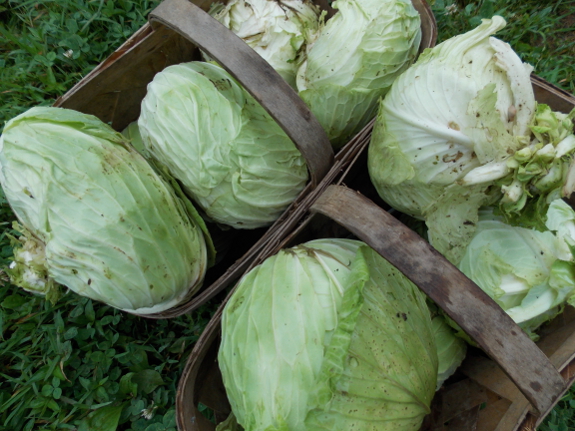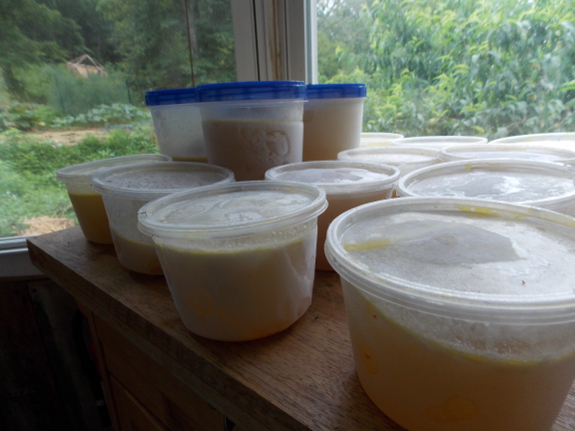
Time lapse soup

The tomatoes are late
this year and the cabbages are copious. The pair of events
is merged in my thinking because my primary use for spring
cabbages is as part of the stock for tomato-based
soups, meaning
that I want tomatoes and cabbages at the same time and in
proportion to each other. While we can definitely eat up
some of the cabbages without tomatoes, I don't want to run out of
cabbage during soup season. So this year I'm experimenting
with time-lapse soup.
What's time-lapse
soup? It's simple --- I process each ingredient when it's on
hand, freeze it, then thaw out various bits to compile into soup
later. For example, I had more chicken carcasses this winter
than I needed right away, so I made broth out of the bones and
froze that. Now I'm thawing the chicken broth and using it
with cabbages, potato onions, parsley, and the end of last year's
garlic to make a denser stock. When the tomatoes come in,
I'm thinking I'll just turn them into paste, then in the winter
I'll thaw containers of paste, stock, green beans, and sweet corn,
add in some carrots, and make my soup that way.

The biggest flaw in
this plan is that I froze the initial broth, thawed it, then froze
it again with vegetables added. I had assumed that
refreezing was forbidden, but the internet explained that the
trouble with refreezing is that the freezer doesn't kill germs,
just puts them on hold. So the germs can multiply during the
thawing process, sit in the refrozen food, then multiply again
during the second thaw, resulting in high microorganism
populations and food that's a bit dicey. Luckily, the
intermediate boiling step sets the clock back, so my refreezing
shouldn't be a problem.
The jury's still out
on whether the winter-compiled soup will taste as good as a soup
made all at once during the summer months. I guess we'll
have to wait and see....
Want more in-depth information? Browse through our books.
Or explore more posts by date or by subject.
About us: Anna Hess and Mark Hamilton spent over a decade living self-sufficiently in the mountains of Virginia before moving north to start over from scratch in the foothills of Ohio. They've experimented with permaculture, no-till gardening, trailersteading, home-based microbusinesses and much more, writing about their adventures in both blogs and books.
Want to be notified when new comments are posted on this page? Click on the RSS button after you add a comment to subscribe to the comment feed, or simply check the box beside "email replies to me" while writing your comment.

Morning Anna!
In my pursuit for the perfect tomato, I have amassed a collection of nearly 300 different varieties that I maintain seed for. Now collecting the seed is just a hobby. I have been trying for years to find a decent early tomato that isn't mealy and bland like most. This year I think I found a keeper. The variety is Sasha Altai from Irkutsk, Siberia. It is classified as a determinate, but I see it as more semi-determinate. I picked the first ripe tomato off at 47 days from transplant, and it was absolutely delicious, and had none of the negative characteristics of early tomatoes. It is listed as 55 DTM. It's pretty acidic on the bite, and sweetens out as you chew. We picked 60 pounds of them yesterday!
Anyways, I saved seed from the tomato that ripened early, and would be happy to share a few with you to trial in your own garden, as I have become enthralled with swapping seeds since discovering the wonderful people of GardenwebI!
Hi Anna and Mark,
One of the 'real' questions about keeping food, frozen or otherwise is, is it as good as fresh food. One of my MD friends said stored food is better! Yikes!! Clueless IMHO!
My knee jerk reaction and probably yours is of course NO! Fresh food is always better. Why?
I read one author who pointed out that most storage methods "denature" the food.
By denature he meant the stored food was no longer able to come back to life. Many enzymes are modified in ways that modifies their behaviour, etc.
I like this definition, but it does make meal preparation more difficult.
I gotta eat what I have when I have it except for seeds. And the seeds need to be soaked [24 hours], sprouted or fermented to undo the phytic acid in them.
For example, most whole wheat bread [ which has its wheat ground but never soaked ] is much more toxic than white bread. Why? There is more phytic acid trying to leach minerals out of me.
So my take is, I need to eat most stuff fresh, well chewed and at least recently alive.
John
Robert --- We'd love to try your favorite early tomato! We've been using Stupice, which is a trooper for us, but I'm always willing to see if something else is better. Please drop me an email at anna@kitenet.net and I'll send you my mailing address. In the meantime, any chance you'd want to write a short guest post summing up the results of your early tomato experiments?
Daddy --- Usually, we do that. But it's been so rainy that our tomatoes aren't even changing color yet, and there's no room in the fridge for a dozen huge cabbages. I doubt they'd last at room temperature for more than a week or so.
I know this is not the best place for this but I did not know where else to place it. It appears you took down the blog about the deer. I just want to say, I thought it was an excellent spot and I can only think you received mail protesting it. If this is the case, it is too bad, because death is part of every person's life even if we do not like to think it so. I go on record as not being offended by what was presented in any way.
In fact I was hoping to see how you processed your food and the steps taken. Keep up the good work.